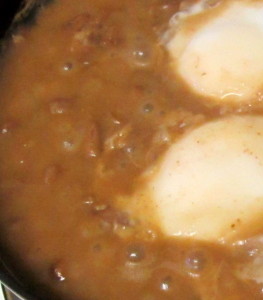Basic Beans in a Slow Cooker
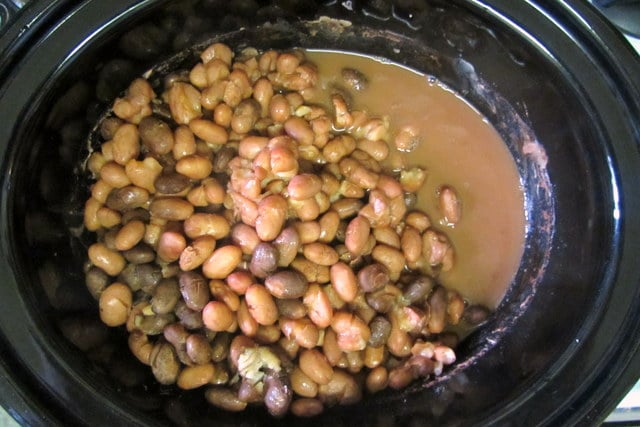
Well, I’ve been meaning to write this, ever since I wrote about cooking beans on top of the stove last June. So, since I seem to be obsessing about slow cookers at the moment… here we are. This is the way I cook beans in a slow cooker, once or twice almost every week.
As I said, I often use the slow cooker to prepare ingredients as much as to cook actual recipes – and we eat beans quite frequently. I prefer dried beans to canned for a couple of reasons. They take less room in the cabinets, I can often get some varieties of dried beans that I may not find canned – and they cost much, much less. My primary reason, though, to be honest, is that I’ve never had what are delicately referred to as “digestive difficulties” with beans I’ve cooked myself – but I learned long ago that I sometimes do with canned beans unless I then cook them further (which seems to take away any advantage they have…) The canned beans sometimes seem to be not quite as thoroughly cooked.
Well, there are a couple of ways you can do this. You can just throw the beans into the pot, put in plenty of water, put the slow cooker on High, and cook for about five hours (six if you think the beans have been sitting around on the shelf a while…) And I do that if I forget to set it up in time…
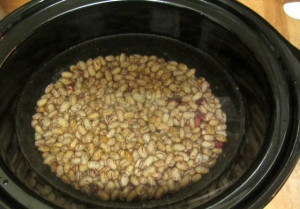
I prefer, though, to soak the beans first, and then cook them. Most beans I then cook on low (unless, again, I need to save an hour or two.) I can’t prove it, but I feel that the soaking helps them cook more evenly, and the longer timing on low often fits into my day better.
I have, though, started cooking kidney beans on high, after soaking them. I started, bluntly, after having a batch that just didn’t cook soft on Low… and then some others that took longer than I’d expect. They do seem a bit more stubborn than other kinds. A few years ago, though, I started reading about a toxic substance that has been identified in kidney beans, which is destroyed by thorough cooking but can actually be made worse by undercooking. (Here is a link to the Food and Drug Administration page about it.) It seems to be diagnosed more in the UK than here in the US – though that may be simply that they are more aware of it…
At any rate, using the slow cooker on High, rather than Low, seems an easy enough way to avoid any risk (especially since I’d started doing that anyway…) If you are cooking for someone with low immunity or greater sensitivity – a small child, or an ill or elderly adult – it may well make sense to just cook all beans on High, automatically, to be certain that it is not an issue, since the toxin can occur in other beans, though in significantly smaller amounts.
All that said… I’ll walk you through cooking Roman beans. I wanted to have them in the morning, for my breakfast. I took three cups and washed them, and picked them over carefully. When I do that, I remove any dirt or pebbles – rare but not unknown – and also any beans that seem discolored or moldy. If I do see moldy beans I usually also remove any split or broken ones, as the mold is more likely to settle into a broken bean without the skin protecting it.
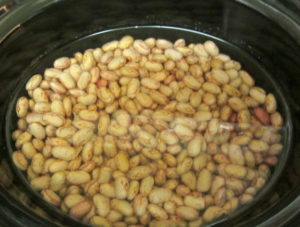
Then I put the beans in the slow cooker, and covered them generously with water. Since I wanted them ready in the morning, I soaked them in the afternoon and evening, and cooked them overnight. It is more common to soak them overnight and cook them during the day for dinner – and I find it often works for me to soak them all morning, then cook them on High in the afternoon.
In this case, I didn’t bother changing the soaking water (though people who do have trouble with gas from beans may want to do that.) I made sure they were still covered with water, with about an inch of water over the top. Then I turned it on shortly before I went to bed.
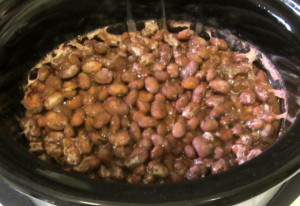
As you see, the top looks a little dried out – but in fact, when I stir it, there’s plenty of liquid left, and those beans really aren’t dried at all. The beans had soaked long enough that they’d absorbed most of the water already. These ended up cooking closer to 9 hours than to 8 – but the extra time does not hurt at all. They were well cooked, not mushy, and ready to be used in any recipe.
Or you can just eat them as is – the different kinds of beans have much more flavor than we often give them credit for, and a spoonful of beans on a tortilla, or with bread, or over grain, is a great foundation for a simple meal. In fact, often my breakfast is beans with eggs, either over tortillas or with muffins – simple, delicious, and a great start to my day!
